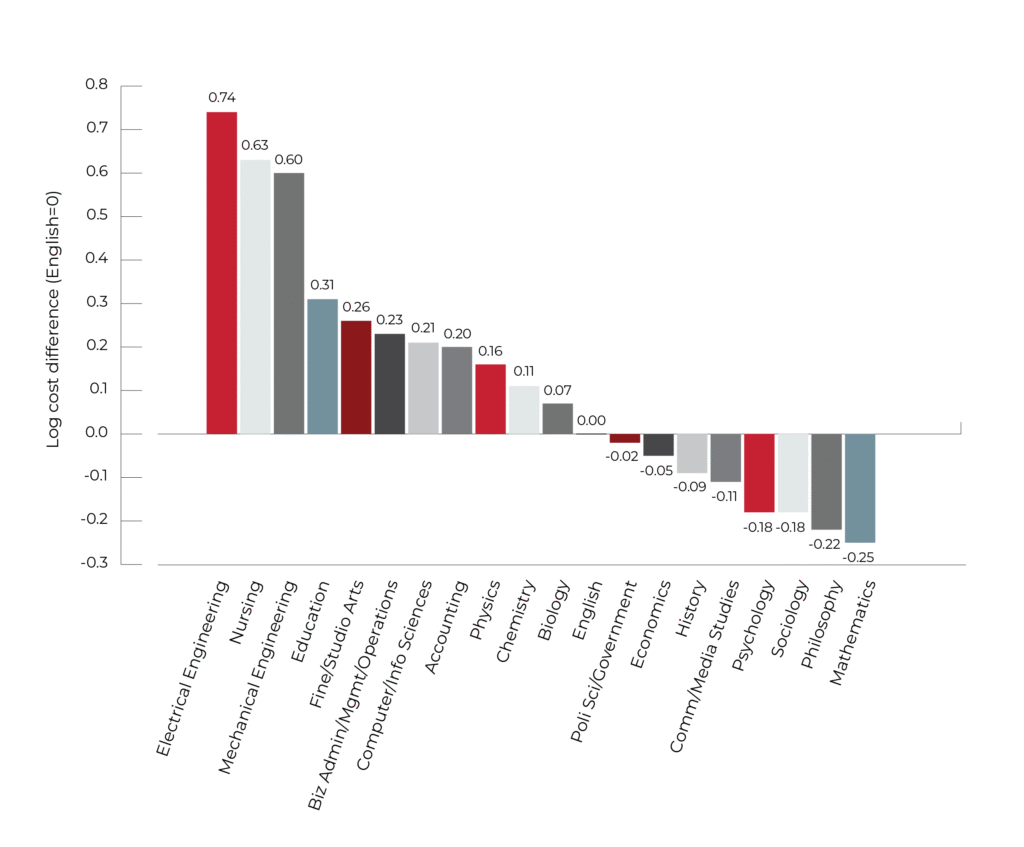
How MAP helps the U make smart, mission-driven choices about academic programs and resource use
Mitzi M. Montoya, Senior Vice President for Academic Affairs, Provost
When we talk about the cost of college, we usually focus on tuition. But behind the scenes, there’s another important question: how much does it actually cost to teach a course or run an academic program?
The answer varies — sometimes by a lot, according to a working paper by the National Bureau of Economic Research. These differences don't mean one subject is more valuable than another. Instead, they reflect what it takes to teach each subject well.
Baseline Cost Differences Across Disciplines

Notes: Each column reports the difference in log of direct instructional cost per SCH between the reported field and English after controlling for institution and year fixed effects. Positive numbers indicate the field is more expensive than English. Sample includes public and private institutions participating in the Delaware Cost Study between 2013-2015. Only departments in the 20 fields listend in Table A1 are included. A small number of observations with missing or outlier data are excluded. Program-level observations are weighed by number of student credit hours multiplied by the inverse of the probability of being included in the sample (estimated at the institution-year level). Costs are in 2015 dollars.
Chart reproduced from: Figure 4. Baseline Cross-Field Log Cost Differences, relative to English, from Hemelt, S. W., Stange, K. M., Furquim, F., Simon, A., & Sawyer, J. E. (2018). Why is math cheaper than English? Understanding cost differences in higher education (NBER Working Paper No. 25314). National Bureau of Economic Research. https://doi.org/10.3386/w25314
Understanding these cost differences is essential to making smart, responsible decisions about how we invest our limited resources. That’s where Mission-Aligned Planning (MAP) comes in. MAP is Academic Affairs’ approach to aligning our academic mission and strategic goals with operational planning. It helps us prioritize what matters most and make intentional choices that support student success, research excellence and societal impact.
Why Do Costs Vary by Subject?
One of the biggest drivers of instructional cost is class size. Some courses can be taught in large lectures. That helps keep costs down. By contrast, others tend to be smaller by necessity because they rely on specialized space, equipment or multiple instructional resources.
Faculty compensation is another factor. In some fields, people can earn much higher salaries in the private sector than in academia. That means universities have to offer more competitive pay to attract and keep qualified instructors in those areas, which adds to the overall cost of delivering those programs.
Universities manage these costs in different ways. Some adjust faculty workloads. Others hire more non-tenure-track instructors, like adjunct faculty, who are expected to teach significantly more than tenured or tenure-track faculty for less pay. Online instruction can also help reduce costs, but while it can be effective for large lecture-style classes, it is more challenging for hands-on, discussion-heavy courses. In some cases, departments offset higher faculty salaries by increasing class sizes. In others, such as lab-based sciences, small classes are essential for safety, accreditation and effective hands-on learning—which drives up costs no matter what.
At a research university like University of Utah, graduate education also plays a key role in the cost equation. Many graduate students serve as Graduate Teaching Assistants (GTAs), helping deliver undergraduate instruction and expanding capacity in large or foundational courses. These roles reduce instructional costs while providing valuable teaching experience.
Each of these strategies has trade-offs. Managing instructional costs while maintaining academic quality requires thoughtful, discipline-specific planning.
Portfolio Management and the Academic Mission
Because disciplines vary so widely in cost, universities often use cross-subsidization to stay balanced. That means using revenue from lower-cost, high-enrollment courses to help fund higher-cost programs.
This internal balancing act helps keep tuition steady across programs and ensures students in all disciplines have access to a high-quality education supported by excellent support services, no matter what their major. But it also raises important questions: How should we prioritize spending? What mix of programs does the university need to fulfill its mission? And how do we protect essential fields that may not generate strong financial returns?
Some programs may enroll fewer students or generate less revenue, but that doesn’t diminish their importance. These programs often fulfill essential public needs or prepare experts in highly specialized fields. In some cases, they provide the foundational knowledge or talent that other sectors rely on—even if the number of professionals needed is small. A strong university can’t focus solely on scale; it must also sustain fields that meet targeted, high-impact needs. MAP helps us ensure that decisions about support and investment reflect both financial realities and the full scope of our academic mission.
The same balancing act applies to research and graduate education. Different types of graduate programs come with different financial models: professional master’s programs often generate revenue; research master’s programs typically break even; and Ph.D. programs require significant investment. Yet these programs are essential to the university’s mission. Doctoral students not only support undergraduate instruction as teaching assistants, they also form the next generation of scholars, educators and innovators. Research conducted through graduate programs drives new discoveries, strengthens Utah’s economy and advances societal impact. Even when they don’t generate immediate revenue, their long-term value is undeniable. A thoughtful funding model must account for both the costs and the contributions of graduate education and research.
MAP helps us take these questions seriously. It gives us tools to evaluate the full picture—not just costs and revenues, but also student demand, workforce needs, academic mission and long-term sustainability.
Balancing Quality and Cost
There’s no one-size-fits-all answer to how universities should manage instructional costs. Each decision comes with trade-offs. Increasing class sizes may save money but can reduce student engagement. Shifting to online delivery might work in some subjects, but not in others. Relying on adjunct faculty may cut expenses but raises concerns about consistency, support and potentially accreditation.
This is why MAP matters. It’s not about cutting corners. Instead, it’s about making informed, mission-aligned choices that protect quality, preserve access and ensure the U remains strong for the future.
At the U, we’re committed to using every dollar wisely. Our students, our state and our mission deserve nothing less.
